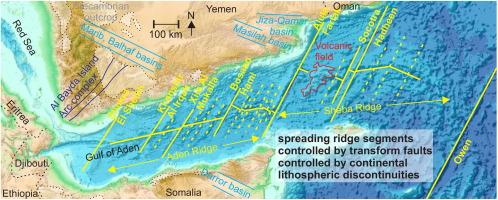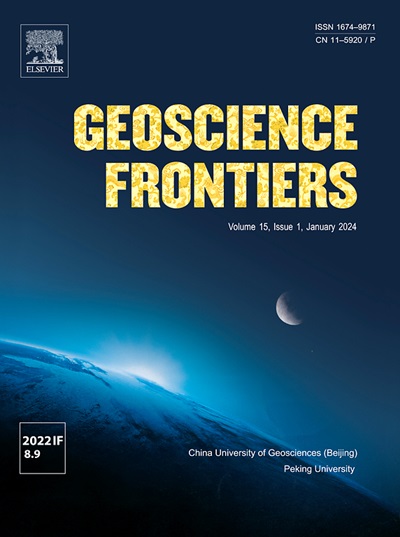Do continental lithospheric discontinuities exert control on tectonic plate motion directions?
IF 8.9
1区 地球科学
Q1 GEOSCIENCES, MULTIDISCIPLINARY
引用次数: 0
Abstract
Plate motion directions, and the orientations of rift zones and oceanic spreading ridges, and of transform faults and fracture zones that are perpendicular to these ridges, are generally controlled by tectonic forces such as slab pull, mantle convection, and mantle plumes. Here, it is hypothesized that within the confines of these general orientations, the exact orientations of these structures, and therefore plate motion directions, are partially controlled by suitably oriented sets of steep continental lithospheric discontinuities (CLDs), which work in concert with these larger tectonic forces.
Previously, the observation has been made that oceanic fracture zones are contiguous with CLDs, such as suture zones and other lithospheric fault zones. Based on high-resolution bathymetry, geological and geophysical data, it is demonstrated here that continents have multiple sets of lineaments parallel to such CLDs, or contiguous with CLDs where they occur farther inland and do not reach the ocean. Published analog experiments suggest that the orientations of transform faults and fracture zones are controlled by these CLDs if the angle between the spreading direction and the CLDs is no more than ∼45°. Spreading ridge segments evolve in an orientation perpendicular to these transform faults and fracture zones, so that the spreading direction becomes parallel to the transform faults and fracture zones. The implication is that the exact plate motion directions are controlled by CLDs, if a set of CLDs is orientated at low angle with the spreading direction. When plate motion directions need to change due to tectonic forces, the new hypothesis predicts that the exact directions may be controlled by a different set of suitably orientated CLDs. During later stages of oceanic spreading, the larger tectonic forces such as slab pull, mantle convection, and mantle plumes become increasingly dominant and plate motion directions may no longer be controlled by the CLDs.
While the hypothesis needs further testing, it has potentially far-reaching implications. For example, Euler pole reconstructions are commonly based on small circle patterns formed by fracture zones and transform faults in the oceanic lithosphere. Oceanic crust older than ∼200 Ma is typically destroyed by subduction, and pre-Mesozoic Euler poles can therefore not be reconstructed based on that method. If the hypothesis presented above is correct, the orientations of CLDs and associated lineament sets may be used as proxies for orientations of past transform faults and fracture zones, at least during early oceanic spreading. The locations of past Euler poles may thus be better estimated based on these CLDs and lineaments, and pre-Mesozoic plate tectonic reconstructions may be much improved in deep geologic time.

大陆岩石圈不连续性是否对构造板块运动方向起控制作用?
板块运动方向、裂谷带和大洋扩张脊以及垂直于这些隆起的转换断层和断裂带的走向,一般受板块拉拔、地幔对流和地幔柱等构造力的控制。在这里,假设在这些一般方向的范围内,这些构造的确切方向,从而板块运动方向,部分地由适当定向的陡峭大陆岩石圈不连续层(CLDs)控制,它们与这些更大的构造力协同工作。在此之前,已经观察到海洋断裂带与cld相邻,如缝合带和其他岩石圈断裂带。基于高分辨率测深、地质和地球物理数据,这里证明了大陆有多组平行于这些叠合带,或与叠合带相邻的叠合带,这些叠合带位于更远的内陆,没有到达海洋。已发表的模拟实验表明,如果扩展方向与断层带之间的夹角不大于45°,则转换断层和断裂带的方向受这些断层带的控制。扩展脊段沿垂直于这些转换断层和断裂带的方向演化,使扩展方向与转换断层和断裂带平行。这意味着,如果一组cld与扩散方向成小角,则确切的板块运动方向由cld控制。当板块运动方向由于构造力而需要改变时,新的假设预测,精确的方向可能由一组不同的合适定向的cld控制。在海洋扩张的后期阶段,较大的构造力如板块拉拔、地幔对流和地幔柱逐渐占主导地位,板块运动方向可能不再受大陆板块的控制。虽然这一假设需要进一步检验,但它具有潜在的深远影响。例如,欧拉极重建通常是基于海洋岩石圈中破裂带和转换断层形成的小圆圈模式。超过~ 200 Ma的海洋地壳通常被俯冲破坏,因此前中生代欧拉极不能基于该方法重建。如果上述假设是正确的,那么至少在早期海洋扩张期间,cld和相关的线集的方向可以作为过去转换断层和断裂带的方向的代表。因此,根据这些叠合带和构造线可以更好地估计过去欧拉极的位置,并且可以在深部地质时期大大改善前中生代板块构造的重建。
本文章由计算机程序翻译,如有差异,请以英文原文为准。
求助全文
约1分钟内获得全文
求助全文
来源期刊

Geoscience frontiers
Earth and Planetary Sciences-General Earth and Planetary Sciences
CiteScore
17.80
自引率
3.40%
发文量
147
审稿时长
35 days
期刊介绍:
Geoscience Frontiers (GSF) is the Journal of China University of Geosciences (Beijing) and Peking University. It publishes peer-reviewed research articles and reviews in interdisciplinary fields of Earth and Planetary Sciences. GSF covers various research areas including petrology and geochemistry, lithospheric architecture and mantle dynamics, global tectonics, economic geology and fuel exploration, geophysics, stratigraphy and paleontology, environmental and engineering geology, astrogeology, and the nexus of resources-energy-emissions-climate under Sustainable Development Goals. The journal aims to bridge innovative, provocative, and challenging concepts and models in these fields, providing insights on correlations and evolution.
 求助内容:
求助内容: 应助结果提醒方式:
应助结果提醒方式:


